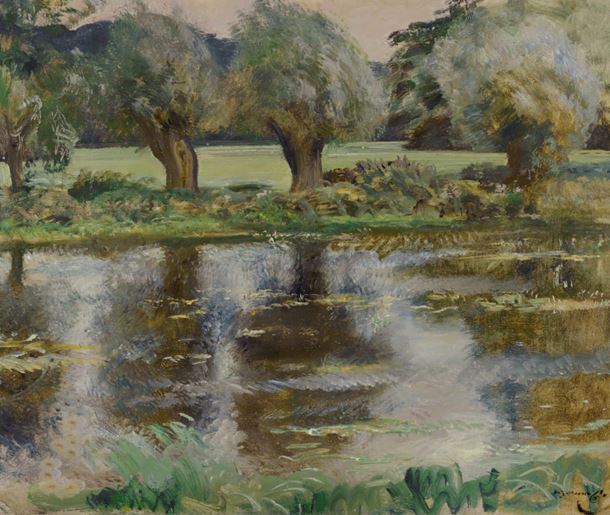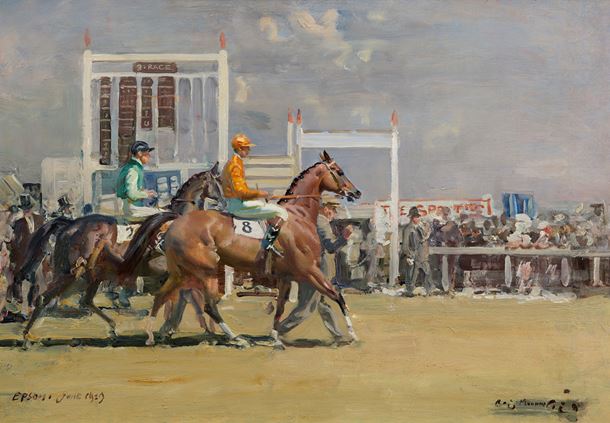back@using System.Web;
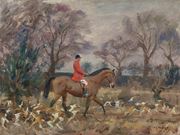
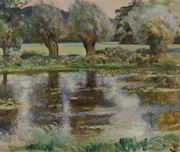
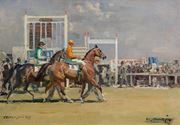
Sir Alfred James Munnings, KCVO, PPRA
(1878 - 1959)
Sir Alfred J. Munnings was an artist of the twentieth century steeped in the traditions and values of the past. His artistic training was not dissimilar to that of a seventeenth century Master. Showing some early talent, Munnings was apprenticed to a firm of lithographers, Page Brothers in Norwich for six years, studying at Norwich School of Art in the evening.
He had some success locally and showed two paintings at the Royal Academy in 1899. In the same year he returned to set up his studio in Mendham, and in an accident lost the sight in one eye. In his early years he supplemented his income by designing posters at which, with is consummate draughtsmanship he excelled. He studied briefly in Paris between 1902 and 1903.
Munnings drew his subject matter from the East Anglian landscape and rural society. A horse fair of 1901 showed an early interest in horses while fairgrounds and rural occupations provided the artist with considerable subject matter. 1910 saw Munnings visit Lamorna in Cornwall where he met Laura (1877-1970) and Harold Knight (1874-1961), lifelong friends, and where he stayed between 1911 and 1916. In 1913 he held his first one-man show at the Leicester Galleries, where Laura Knight, DBE, RA showed.
In 1918 Munnings was appointed as a war artist with the Canadian Cavalry Brigade, producing an important body of work for the Canadian Government. Munnings settled in Dedham in 1918, marrying Violet in 1920. He was elected Royal Academician in 1925, to the RWS in 1929, in 1944 Munnings was knighted and elected President of the Royal Academy between 1944 and 1949. In this latter role he famously made known his utter contempt for ‘Modern Art’. Munnings was a prolific artist and a consummate draughtsman, whose work as a war artist raised his profile and reputation. Best known for his equestrian works, portraits and racing works, Munnings range was enormous. He excelled in landscape and scenes of rural life, recording a way of life that was coming to an end.
His works are in the collections of HM the Queen, J. Mitchell Chapman, Lord Fairhaven and Major Sir Reginald Macdonald Buchanan. His works can be found in museums in: Birmingham; Liverpool; London, Tate Gallery; Norwich; Preston; USA, Yale University; Brisbane and Melbourne.
He had some success locally and showed two paintings at the Royal Academy in 1899. In the same year he returned to set up his studio in Mendham, and in an accident lost the sight in one eye. In his early years he supplemented his income by designing posters at which, with is consummate draughtsmanship he excelled. He studied briefly in Paris between 1902 and 1903.
Munnings drew his subject matter from the East Anglian landscape and rural society. A horse fair of 1901 showed an early interest in horses while fairgrounds and rural occupations provided the artist with considerable subject matter. 1910 saw Munnings visit Lamorna in Cornwall where he met Laura (1877-1970) and Harold Knight (1874-1961), lifelong friends, and where he stayed between 1911 and 1916. In 1913 he held his first one-man show at the Leicester Galleries, where Laura Knight, DBE, RA showed.
In 1918 Munnings was appointed as a war artist with the Canadian Cavalry Brigade, producing an important body of work for the Canadian Government. Munnings settled in Dedham in 1918, marrying Violet in 1920. He was elected Royal Academician in 1925, to the RWS in 1929, in 1944 Munnings was knighted and elected President of the Royal Academy between 1944 and 1949. In this latter role he famously made known his utter contempt for ‘Modern Art’. Munnings was a prolific artist and a consummate draughtsman, whose work as a war artist raised his profile and reputation. Best known for his equestrian works, portraits and racing works, Munnings range was enormous. He excelled in landscape and scenes of rural life, recording a way of life that was coming to an end.
His works are in the collections of HM the Queen, J. Mitchell Chapman, Lord Fairhaven and Major Sir Reginald Macdonald Buchanan. His works can be found in museums in: Birmingham; Liverpool; London, Tate Gallery; Norwich; Preston; USA, Yale University; Brisbane and Melbourne.




